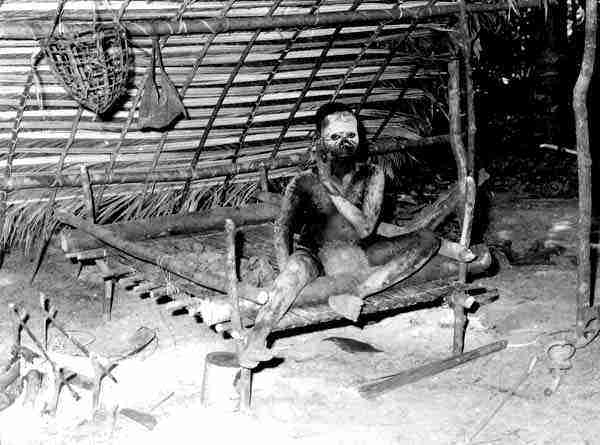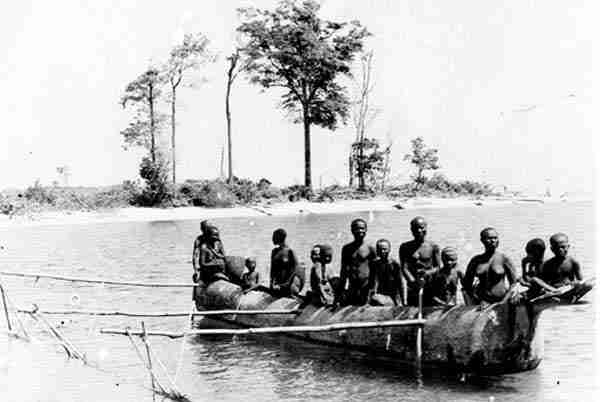The traditional Andamanese attitude towards the family differed substantially from that of other societies. It is indeed unique. Primitive societies tend to have complex classificatory systems with matching elaborate nomenclature for family relationships. These are often based on the concept of the clan and can be of a complexity to stagger the modern city dweller who has problems distinguishing between cousins and nephews. Human societies tend to take the family, the people of the same blood, very seriously indeed. Not so the Andamanese: their term for "family" covered only the nuclear family of mother, father and children and even this was overshadowed to the point of near-invisibility by the local group. Grand-parents, for example, were regarded as being another family. Under these circumstances it will not come as a surprise to find terms denoting degrees of relationship remarkably few. Indeed, the Andamanese languages are unique in having no proper terms for "mother" and "father." The words used in their place on closer inspection turn out to be mere terms of respect, honorifics, which were used to address older people generally.
Degrees of consanguinity interested the Andamanese only insofar as they were needed to set limitations to marriage between blood relations. The detailed rules of who was allowed and who was not allowed to marry varied slightly from tribe to tribe but marriage between cousins seems to have been the generally accepted limit. Whether the bar to marriage extended to those related by adoption is not clear from the records.
The remarkably indifferent Andamanese attitude towards relationships of the blood was illustrated by remarks the anthropologist Radcliffe-Brown made when he tried and failed to construct a native genealogy. He modestly blamed his own inexperience in the use of genealogical methods for his problems but the system of child adoption alone would be a nightmare to even the most professional genealogist. There are no later publications of importance on the subject and Radcliffe-Brown's remains essentially the last word on the subject today:
The systems of relationship of savage peoples are often very difficult to study, even with a thorough mastery of the native language. My account of the Andamanese system is not perhaps complete and is therefore open to error . . . I have [since] had the opportunity of studying in Australia several examples of "classificatory" [i.e. clan-based] systems of relationship, and can now say very definitively that such a system presents an extreme contrast to the system of the Andamans. My failure fully to comprehend the Andamanese system was partly due to the difficulties of the language, in which I did not have time to become expert, and partly to the nature of the Andamanese terms, of which it is by no means easy to discover the meaning, even with careful observation.
The matter clearly worried him, for later in the same book he also wrote:
The difficulty of being really sure on these matters is due (1) to the fact that the breaking-up of the local organization has produced many changes in their [Andamanese] customs, and (2) to the difficulty of questioning the natives on matters connected with relationships when they have no words in their language to denote any but the simplest relationships.
How deeply the Andamanese respected their elders is illustrated dramatically by the absence of a specific word for "mother" and "father." In their stead, general honorifics were used: in Aka-Jeru t'a-mimi ("my mother") or aka-mimi ("his mother") as well as t'a-mai ("my father") or aka-mai ("his father") show how the honorifics mimi ("Lady" or "Madam") and maia ("Sir") were used. T'a-mimi aka-mai meant "my mother's father." Other Andamanese languages used different honorific terms but the system behind them all was the same. Mimi Oka simply meant "Mrs. Oka" and it tells us that Oka was older than the person addressing her. Oka aka-mai meant "Oka's father," aka-mai Oka "his father Oka." The following list gives additional examples.
There were no special terms for grandparents. A grandfather from the mother's side was simply addressed as t'a-mimi aka-mai ("my mother's father") with grandmothers described similarly. These compound descriptive terms were, however, seldom used. The same applied to all other terms of relationships: the relative age was more important than his or her biological relationship. Nor are the 'precise terms' nearly as precise as they look. For example, Akar-Bale jat could mean specifically "grandchild" but the word was also used by any person of any child that could be his or her grandchild.
Children were much loved, pampered and spoiled by all the members of the local group. They could be reprimanded for improper behaviour but they were never punished. Childhood ended with the Onset of puberty, usually around 15 years of age for both sexes. Ceremonies with severe discipline had to be passed before the adolescents were accepted as adult. Boys then moved to a bachelor's hut of their own and had to cook and eat their own meals until they married. Girls lived with their parents, real or adopted. For earlier times there is some evidence that spinsters lived like bachelors in their own hut until marriage.
Children were the main purpose of marriage and no marriage was regarded as consummated until a child had been born: a man returning to his wife from a hunting trip would not greet her first if she had not given him a child, nor would the surviving spouse be looked on as the chief mourner if the partner in a childless marriage died.
Infants were carried around by their mothers and occasionally by their fathers in bark slings. As soon as they could walk, children enjoyed a very large measure of freedom. The traditional sex roles were, however, playfully exercised from an early age. Fathers made toy bows and arrows for their sons when they reached the age of six and they could accompany the adult hunters on their expeditions, learning to be hunters themselves. Girls of the same age followed their mothers on gathering forays where they learnt to distinguish edible from poisonous matter, to collect vegetables, to catch fish and to pick up anything edible in the reefs and on the beaches. Between such serious child's play, the children could also romp about and play games around the village and on the beaches, as children are wont to do anywhere. Aryoto children also spent as much time in the water as on dry land and learnt to swim as soon as they could walk.
A peculiarity of all Andaman tribes was their system of adopting children. It was quite common for parents to give away their own child for adoption at age 6 to 10. Fertility always seems to have been low in the Andamans and children were much loved and highly prized. Orphans were adopted as a matter of course by another family within the same local group and thereafter were regarded by all and in all respects as children of their new parents. A much more unusual type of adoption took place when a couple gave away their child to a couple in another local group, often while adopting a child from yet a third couple themselves. Children adopted through this second type could marry within their adoptive family. They could also be adopted further without reference to the original parents beyond informing them where their child had gone so that they could keep up their visits. Couples could adopt as many children as they wished or could find but they were expected to treat them as their own, with kindness and consideration. The adopted children in return had to treat their foster parents with the filial respect so important to Andamanese society. The Onge also knew a temporary form of adoption when children were kept for some years by an adopting couple before they returned to their biological parents. Occasionally temporary adoptions could turn into permanent ones when the original parents did not request the return of the child. It is not difficult to understand that with all this going on, census taking or genealogical research was a hopeless task. The adoptive parents happily, and on their terms truthfully, declared their adopted children to be their own.


